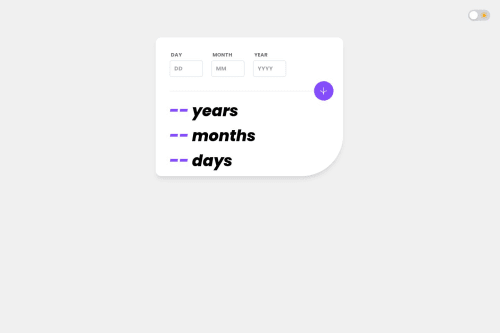Advanced Animated Numbers with Light & Dark Mode Age Calculator

Solution retrospective
What I'm Most Proud Of
I'm most proud of the advanced animated numbers feature and light & dark mode, which adds an engaging and dynamic aspect to the age calculator. It enhances the user experience and makes the tool more visually appealing.
What I Would Do Differently Next Time
Next time, I would focus on improving the accessibility of the age calculator. Making it fully accessible to people with disabilities would ensure usability for a wider audience.
What challenges did you encounter, and how did you overcome them?Challenges and Solutions
Challenge: Implementing Animated Numbers
Implementing animated numbers required a thorough understanding of the animation process and synchronizing the animation with the age calculation.
Solution:Overcame this challenge by integrating the setInterval function to create a simple animation. By synchronizing the animated numbers with the age calculation, I managed to achieve a seamless and visually captivating effect.
Challenge: Implementing a Seamless Switch between Light and Dark Modes
Implementing a seamless switch between light and dark modes without affecting the functionality of the age calculator.
Solution:Overcame this challenge by using CSS variables and JavaScript to dynamically update the color scheme based on user preference. Ensured that the switch between modes was smooth and visually appealing, enhancing the overall user experience.
Challenge: Optimizing the Performance of the Age Calculator
Optimizing the performance of the age calculator, especially regarding the animation of numbers.
Solution:Overcame this challenge by fine-tuning the animation sequences and minimizing unnecessary DOM manipulation. Additionally, implemented CSS hardware acceleration techniques to enhance the performance of the animated numbers. With the setInterval function, I ensured smoother and more efficient animations.
Next time, I would focus on improving the accessibility of the age calculator. Making it fully accessible to people with disabilities would ensure usability for a wider audience.
Please log in to post a comment
Log in with GitHubCommunity feedback
No feedback yet. Be the first to give feedback on Abdul Rahman's solution.
Join our Discord community
Join thousands of Frontend Mentor community members taking the challenges, sharing resources, helping each other, and chatting about all things front-end!
Join our Discord